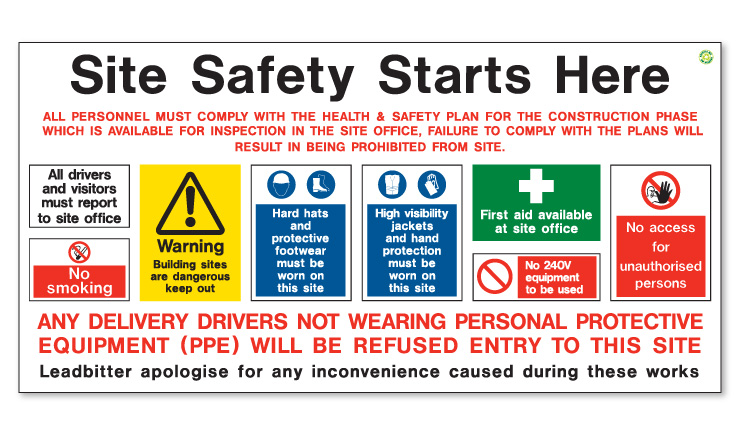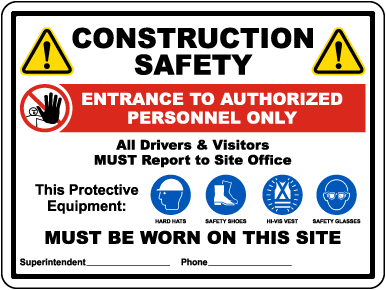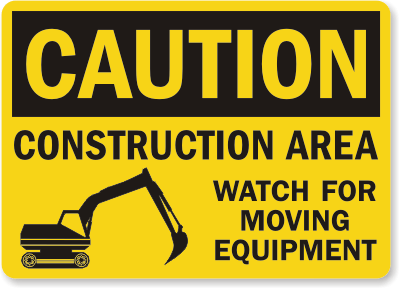A Detailed Review of Safety Signs and Their Performance in Communicating Hazards and Safety Protocols
Safety indicators play a vital role in making certain awareness and compliance within numerous environments, from industrial settings to public areas. The effects of these indicators extend beyond simple conformity, motivating a closer evaluation of their effect on office security and danger mitigation.
Types of Security Indicators
In numerous settings, comprehending the kinds of safety and security signs is necessary for ensuring the well-being of individuals. Safety indications are categorized largely into four kinds: indication, mandatory indications, restriction indications, and emergency situation indications. Each type serves an unique function in interacting important details.
Warning indicators, commonly yellow with black signs, alert individuals to hazardous problems or prospective risks, such as slippery floorings or falling objects - Construction Signs. These indications are important for stopping mishaps by informing individuals of dangers they may encounter
Compulsory indicators, blue and typically circular, show actions that must be required to make sure safety, such as putting on individual safety equipment or complying with specific safety and security procedures. Conformity with these indicators is crucial for maintaining a secure atmosphere.
Prohibition indications, identified by a red circle with a diagonal line, suggest actions that are not allowed, such as "No Smoking" or "Do Not Go into." These indications assist to avoid hazardous behaviors that might lead to injuries or mishaps.
Lastly, emergency indicators, generally environment-friendly, provide directions for fire escape and safety and security devices places. Their clear presence and prompt acknowledgment are crucial throughout emergency situations, helping with swift and secure discharges.
Design Principles of Safety And Security Signs
Efficient layout concepts of security signs are critical for making certain that they share details swiftly and plainly to individuals in various environments. The key objective of a safety and security indicator is to communicate required safety measures and prospective dangers, and this can be achieved via a collection of vital design elements.
First, shade plays an important role in sign acknowledgment. Details colors are universally linked with certain significances; for example, red indicates threat or restriction, while eco-friendly signifies safety or authorization - Construction Signs.
Icons and icons need to be generally understood and quickly recognizable, commonly using conventional pictograms that go beyond language obstacles. The layout must be sensible, placing the most essential details at eye level and preventing mess to improve comprehension. Longevity and weather resistance are important for exterior signs, making certain that they preserve presence and efficiency under various conditions. By adhering to these design principles, safety and security signs can successfully meet their purpose of advertising awareness and security in varied settings.
Performance and Interaction

Effective communication through safety and security signs counts on universal signs and standard language. This approach minimizes misunderstandings and gives clear guidance across diverse populations, consisting of those with differing levels of language efficiency. A straightforward red circle with an angled line widely communicates "prohibition," while a green square suggests security or acceptable actions.
Moreover, the critical positioning of security check in risky locations additionally enhances their capability. By positioning signs where they are most required, organizations can better prevent accidents and promote a culture of security. The assimilation of reflective materials and lit up signage also plays a vital duty in making certain visibility under various problems, thus enhancing the value of these vital communication devices in keeping a secure environment.

Regulatory Specifications and Compliance
Countless regulatory requirements govern the layout, positioning, and upkeep of safety indicators to make sure compliance and boost public safety. These criteria are established by different organizations, including the American National Requirement Institute (ANSI) and the Occupational Security and Health And Wellness Administration (OSHA), which offer standards on the specifications for materials, colors, and signs used in safety and security signs.
Conformity with these requirements is important as it not just cultivates a risk-free atmosphere yet additionally lessens lawful liabilities. Safety signs must be notably placed in areas where risks exist and need to be preserved in review a noticeable and understandable condition. Making use of standardized icons and language assists in reducing complication and guarantees that the designated message is successfully communicated to a varied audience.
Furthermore, companies are called for to carry out regular audits and examinations of their safety and security signage to ensure ongoing compliance with relevant regulations. Failure to abide by these requirements can result in penalties, increased danger of mishaps, and jeopardized safety and security for employees and the public. Thus, understanding and applying regulative standards is necessary for any entity aiming to prioritize safety and security through reliable interaction.
Importance in Work Environment Safety And Security
Acknowledging the critical duty security signs play in work environment security is important for fostering a safe work atmosphere. Construction Safety Signs. These signs work as visual cues, effectively communicating needed safety measures and prospective hazards to site visitors and staff members alike. By providing clear details, security signs reduce the threat of mishaps and injuries, making certain that employees know their surroundings and the associated threats
The significance of safety indicators expands past mere compliance with policies; they are indispensable to growing a safety-oriented society within the organization. Consistent usage of well-designed signs reinforces security procedures, encouraging employees to adopt safe practices and stay cautious. This proactive technique not just secures individuals yet also boosts general productivity by reducing downtime related to mishaps.
Additionally, safety signs are vital throughout emergency scenarios. They direct personnel towards leaves, emergency tools, and secure zones, facilitating quick evacuations and potentially conserving lives. The effectiveness of these indications pivots on their presence, suitability, and clearness to the certain dangers existing in the workplace. Investing in top quality safety signage is a basic facet of any kind of comprehensive office security technique, showing a company's commitment to prioritizing the well-being of its workforce.
Final Thought

By sticking to these design concepts, security signs can properly meet their objective of advertising awareness and security in varied settings.
Identifying the important role safety signs play in work environment safety is necessary for promoting a safe job atmosphere. Investing in high quality safety look at this site and security signs is a fundamental element of any type of comprehensive work environment security strategy, showing an organization's dedication to prioritizing the well-being of its workforce.
In final thought, safety indicators play an important function in sharing hazards and safety and security procedures throughout various settings. Ultimately, the reliable execution of safety indications adds dramatically to run the risk of decrease and the promotion of a culture of safety within organizations.
Comments on “Building Site Signs: Specialist Signage to Guide Employees and Visitors”